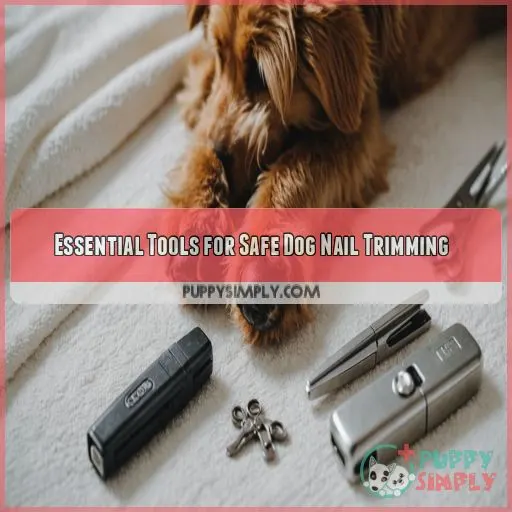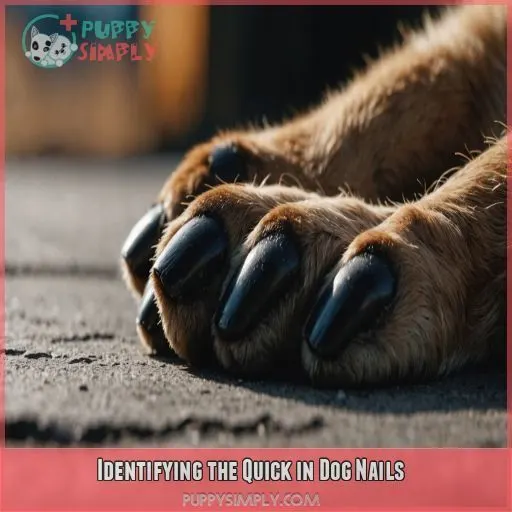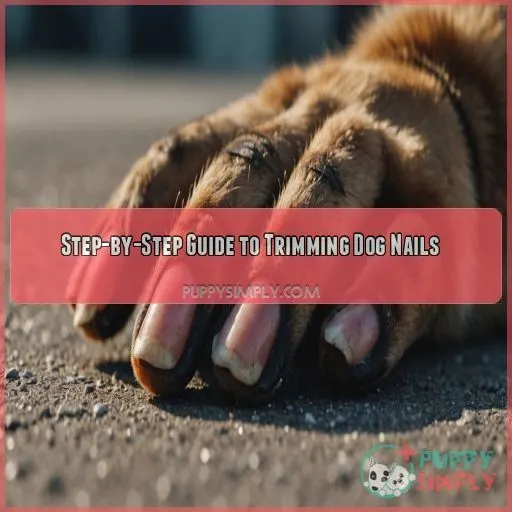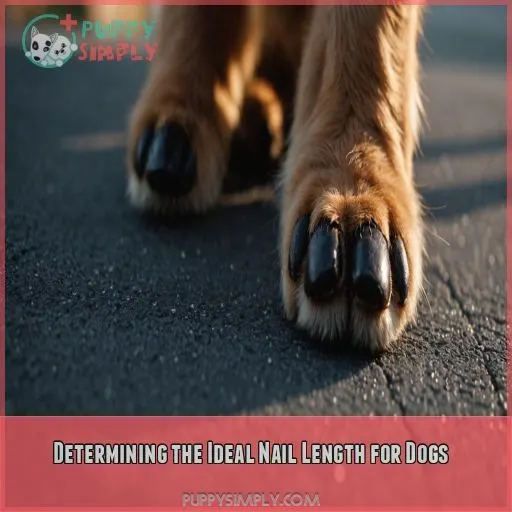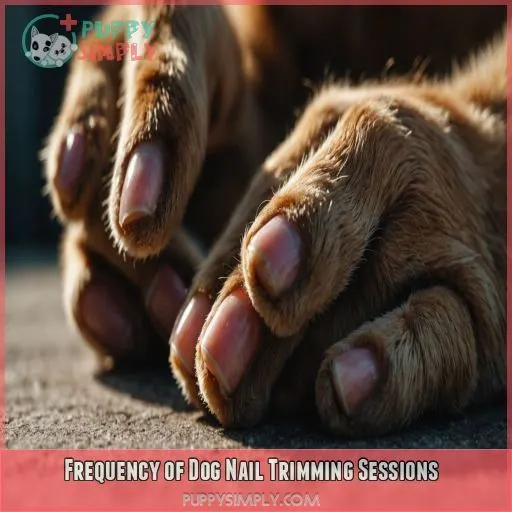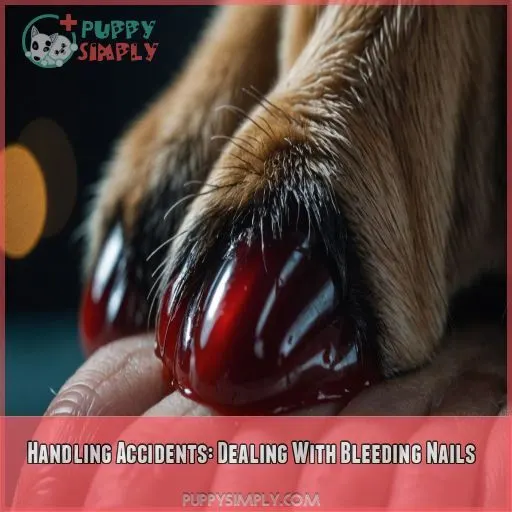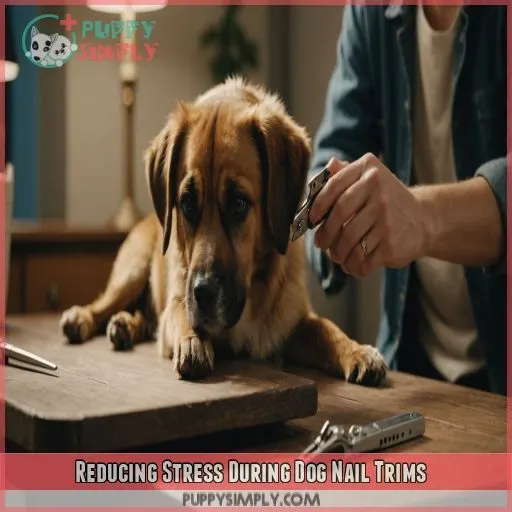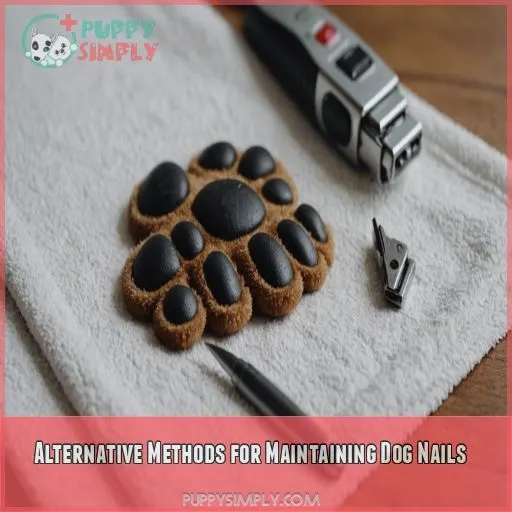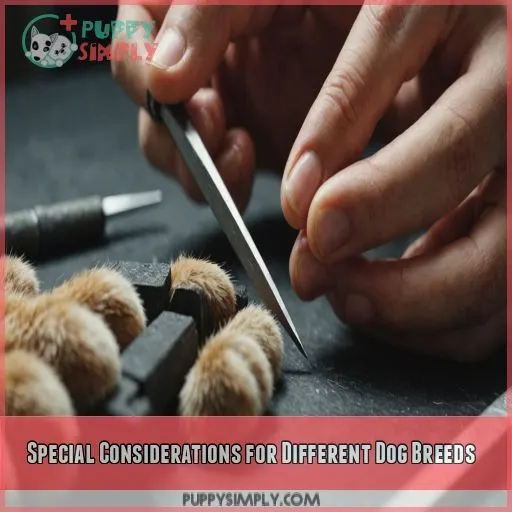This site is supported by our readers. We may earn a commission, at no cost to you, if you purchase through links.
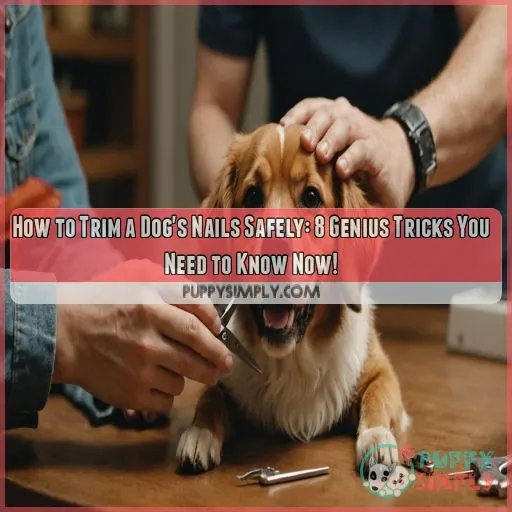 Ready to tackle your pup’s claws without breaking a sweat? Trimming your dog’s nails safely isn’t as scary as it sounds!
Ready to tackle your pup’s claws without breaking a sweat? Trimming your dog’s nails safely isn’t as scary as it sounds!
Start by gathering the right tools: nail clippers, styptic powder, and treats.
Identify the quick (the pink part) and trim around it, not across.
Take it slow, cutting small portions from the top left, right, and middle tip.
For dark nails, look for a chalky white ring.
Keep your furry friend calm with positive reinforcement and a cozy environment.
Stick around, and we’ll share some genius tricks to make nail trimming a breeze for both you and your pooch!
Table Of Contents
- Key Takeaways
- Essential Tools for Safe Dog Nail Trimming
- Identifying the Quick in Dog Nails
- Step-by-Step Guide to Trimming Dog Nails
- Determining the Ideal Nail Length for Dogs
- Frequency of Dog Nail Trimming Sessions
- Handling Accidents: Dealing With Bleeding Nails
- Reducing Stress During Dog Nail Trims
- Alternative Methods for Maintaining Dog Nails
- Special Considerations for Different Dog Breeds
- Frequently Asked Questions (FAQs)
- What is the most gentle way to trim a dog’s nails?
- How do you cut a dog’s nails for beginners?
- What not to do when cutting dogs nails?
- How to trim dog nails that are overgrown?
- Can I use human nail clippers on my dog?
- How do I trim my dogs black nails?
- Is it necessary to trim my dogs dewclaws?
- Should I file my dogs nails after trimming?
- Can certain medications affect my dogs nail growth?
- Conclusion
Key Takeaways
- Don’t be scared! You can do this. Gather nail clippers, styptic powder (for any accidents), and treats for positive reinforcement.
- Take it slow and steady. Identify the quick and carefully trim around it. Go little by little, especially with dark nails where you need to look out for that chalky white ring.
- Keep your doggo calm. Create a cozy environment with soothing music and scents, and always use positive reinforcement with treats and praise.
- Smooth those edges! Don’t forget to use a nail file or grinder to buff away any sharp points after clipping. It’s like giving your pup a mini-manicure.
Essential Tools for Safe Dog Nail Trimming
You’ll need the right tools to trim your dog’s nails safely and effectively. Let’s explore the essential items you should have on hand before attempting this important grooming task.
Nail Clippers and Grinders
You’ve got two main options for trimming your pup’s nails: clippers or grinders. Clippers are quick and quiet, while grinders offer precision. Whichever you choose, make sure it’s the right size for your furry friend. Safety first, wagging tails second!
Styptic Powder for Bleeding Control
Accidents happen, so keep styptic powder handy. It’s your nail-trimming safety net! If you nick the quick, don’t panic. Just dab on this miracle dust to stop bleeding fast. No styptic powder? Flour or cornstarch can pinch-hit in a pinch.
Treats for Positive Reinforcement
Don’t forget the treats! They’re your secret weapon for turning nail trims into a positive experience. Stock up on your pup’s favorites and dole them out generously. With the right rewards, your furry friend might even start looking forward to grooming time!
Nail Files for Smoothing
After treating your pup, don’t forget to smooth those rough edges! Nail files are your secret weapon for a polished finish. They’re like a spa day for your dog’s paws, preventing snags and scratches. Plus, it’s a great bonding opportunity!
Identifying the Quick in Dog Nails
Now that you’ve got your tools ready, let’s tackle the trickiest part of nail trimming: finding the quick.
It’s like a game of "Operation" for your pup!
In light-colored nails, you’ll spot the pink quick easily.
But dark nails? That’s where it gets tricky.
Look for a chalky white ring – that’s your cue to stop.
Don’t forget those pesky dewclaws!
They’re like the wisdom teeth of dog nails – easy to overlook but important to maintain.
Step-by-Step Guide to Trimming Dog Nails
Trimming your dog’s nails doesn’t have to be a nail-biting experience for you or your furry friend. With our step-by-step guide, you’ll learn the tricks of the trade to make nail trims a breeze, keeping your pup’s paws in tip-top shape without breaking a sweat.
Preparing Your Dog for the Trim
Now that you’ve spotted the quick, it’s time to prep your pup. Create a calm environment and gather your supplies. Here’s your pre-trim checklist:
- Treats at the ready
- Plenty of patience
- Positive vibes only
Proper Positioning and Holding Techniques
Now that your pup’s ready, let’s master the art of pet nail care safety! Position yourself comfortably and gently hold your dog’s paw. Remember, control is key, but keep it relaxed – you’re not arm wrestling!
Clipping Technique for Light-Colored Nails
Ready to tackle those light nails? Here’s the scoop: Identify the quick, choose your clipper, and make small, angled cuts. Remember, less is more! If you hit the quick, don’t panic—styptic powder’s your best friend.
Trimming Dark or Black Nails
Dark nails? Don’t sweat it! Look for the white ring around the quick. Take tiny nibbles, not big bites. If you’re unsure, ask your vet for a demo or consider using a grinder instead.
Filing Rough Edges After Clipping
After clipping, don’t forget to smooth those rough edges! Grab a nail file or grinder and gently buff away any sharp points. It’s like giving your pup a mini-manicure – they’ll thank you for it!
Determining the Ideal Nail Length for Dogs
Now that you’ve mastered the trimming technique, let’s talk about the perfect nail length for your furry friend.
It’s not one-size-fits-all, folks!
The ideal length depends on your dog’s breed, activity level, and nail shape.
Here’s a pro tip: if you hear that tell-tale click-clack on the floor, it’s time for a trim.
Aim to keep the nails just off the ground when your pup’s standing.
Think of it like a manicure for your pooch – neat, tidy, and comfortable.
Frequency of Dog Nail Trimming Sessions
Wondering how often you should trim your furry friend’s nails? You’re not alone – it’s a common question that can make even seasoned dog owners scratch their heads. Let’s unpack the factors that influence nail growth and help you create a trimming schedule that’ll keep your pup’s paws in tip-top shape.
Factors Affecting Nail Growth
Ever wonder why Fido’s nails grow faster than your neighbor’s pup? It’s not just luck of the draw. Your dog’s nail growth is influenced by:
- Age: Puppy claws sprout like weeds
- Breed: Some dogs are born manicure magnets
- Diet: Nutritional powerhouses fuel faster growth
- Activity level: Couch potatoes need more trims
These factors determine how often you’ll need to break out the clippers.
Signs That Nails Need Trimming
You’ve mastered nail growth factors, but how do you know when it’s time to trim? Watch for these telltale signs:
| Sign | What It Means | Action |
|---|---|---|
| Clicking sounds | Nails too long | Time to trim |
| Altered stance | Discomfort walking | Check nail length |
| Visible curve | Overgrown nails | Schedule a trim |
Don’t let your pup become a tap dancer – keep those nails in check!
Creating a Nail Trimming Schedule
Once you’ve spotted those telltale signs, it’s time to create a nail-trimming game plan. Think of it as your pup’s spa day! Most dogs need a trim every 3-4 weeks, but it’s not one-size-fits-all. Active pooches might need less frequent touch-ups, while couch potatoes may require more. Adjust your schedule based on your furry friend’s individual needs.
Handling Accidents: Dealing With Bleeding Nails
Even the most careful pet parents can accidentally cut their dog’s quick during nail trims. Don’t panic if you see blood – we’ve got you covered with expert tips to handle this common mishap and keep your furry friend comfortable.
Applying Styptic Powder
You’ve nicked the quick. Don’t panic! Styptic powder‘s your best friend here. Dip the nail in this magical dust, and voila! Bleeding stops like you’ve waved a wand. No styptic powder on hand? Fear not! We’ll cover alternatives next. For now, remember: a little goes a long way in your pet nail care arsenal.
Alternative Methods to Stop Bleeding
No styptic powder? Don’t panic! Your kitchen’s got you covered. Grab some cornstarch or flour – they’re natural options that’ll stop the bleeding in a pinch. Just dab a bit on the nail and apply gentle pressure. It’s like magic! Remember, these DIY options are your trusty sidekicks in pet nail care emergencies.
When to Seek Veterinary Assistance
Sometimes, even with the best intentions, things can go south. If your pup’s nail won’t stop bleeding after 10-15 minutes or looks infected, it’s time to call in the pros. Don’t panic—your vet’s seen it all before! They’ll patch up your furry friend and give you tips to avoid future nail nightmares.
Reducing Stress During Dog Nail Trims
Trimming your dog’s nails doesn’t have to be a stressful ordeal for either of you. With the right techniques and a positive attitude, you can turn nail trims into a bonding experience that your pup might even look forward to.
Desensitization Techniques
Desensitization is key to stress-free nail trims. Start by:
- Gently massaging your pup’s paws daily.
- Introducing nail clippers gradually, letting your dog sniff and investigate.
- Simulating the trimming process without actually cutting.
Using Positive Reinforcement
You’ve got this, dog owner! Positive reinforcement is your secret weapon for stress-free nail trims. Here’s your game plan:
| Action | Reward |
|---|---|
| Paw touch | Treat |
| Clipper sniff | Praise |
| One nail clipped | Belly rub |
| Full paw trimmed | Favorite toy |
Consistency is key. With patience and plenty of rewards, you’ll turn nail trims into a tail-wagging experience!
Creating a Calm Environment
- Choose a quiet, cozy spot
- Play some soothing tunes
- Use calming scents like lavender
Alternative Methods for Maintaining Dog Nails
You don’t have to rely solely on nail clippers to keep your pup’s nails in check. From using grinders to encouraging natural wear through exercise, there are several alternative methods that can make nail maintenance a breeze for both you and your furry friend.
Using a Nail Grinder
Want to ditch the clippers? Try a nail grinder! It’s like a mini-manicure for your pup. Choose a quiet model to keep Fido calm. Start slow, letting your dog sniff the grinder first. Gradually introduce the sensation, rewarding with treats. You’ll be a pro in no time, giving your furry friend salon-worthy paws!
Natural Nail Wear Through Exercise
Want to skip the nail clippers? Let your pup’s paws do the work! Pavement walks, dog parks, and hiking trails can naturally file those nails down. Frisbee play and agility courses are fun ways to keep nails in check. Remember, though, some dogs still need occasional trims. It’s all about finding the right balance for your furry friend!
Professional Grooming Services
Can’t handle the nail-trimming drama? Professional groomers are your secret weapon! They’ve got the skills to make your pup’s pedicure a breeze. From mobile services to breed-specific experts, there’s an option for every pooch. Sure, it’ll cost more than DIY, but hey, isn’t your sanity worth it? Stick to a regular grooming schedule for best results.
Special Considerations for Different Dog Breeds
Trimming your dog’s nails isn’t a one-size-fits-all job. Different breeds have unique nail characteristics that require specific techniques, so you’ll need to tailor your approach based on your furry friend’s paw peculiarities.
Trimming Nails of Small Vs. Large Dogs
Trimming your pup’s nails isn’t one-size-fits-all! For tiny paws, human nail clippers might do the trick. Large dogs? You’ll need heavy-duty nail clippers. Remember, smaller breeds often need more frequent trims. Locating the quick is trickier on big dogs, so take extra care. Safety tip: Always reward your furry friend, no matter their size!
Dealing With Thick or Curled Nails
- Use heavy-duty clippers designed for thick nails
- Soften nails with a warm bath before trimming
- Tackle curled nails in small increments to avoid discomfort
Managing Dewclaws and Extra Toes
Don’t forget those pesky dewclaws! These "thumb" nails can become ingrown if neglected. Trim them gently, just like regular nails. Got a polydactyl pup? Those extra toes need love too! Keep an eye out for any abnormal growth or discomfort. If you’re unsure, let your vet be your guide. They’re the real toe experts!
Frequently Asked Questions (FAQs)
What is the most gentle way to trim a dog’s nails?
Puppy parents, fear not! You’ll be the top dog at nail trimming. Use positive reinforcement, take it slow, and keep treats handy. Gently hold your pup’s paw, clip just the tip, and reward generously. You’ve got this!
How do you cut a dog’s nails for beginners?
Start by getting your pup comfortable with paw handling. Use dog-specific clippers, trim a tiny bit at a time, and reward generously. If you’re nervous, practice on a stuffed toy first. Remember, slow and steady wins the race!
What not to do when cutting dogs nails?
Picture a tightrope walker: that’s you trimming your dog’s nails. Don’t rush, force, or clip too short. Avoid the quick like the plague. Don’t ignore your pup’s stress signals. Remember, slow and steady wins this race.
How to trim dog nails that are overgrown?
You’ll need patience and a gradual approach. Start by trimming small bits frequently, rather than taking off too much at once. Use treats to keep your pup calm, and consider a nail grinder for smoother results.
Can I use human nail clippers on my dog?
You can use human nail clippers on small dogs or puppies, but it’s not ideal for larger breeds. They’re not designed for thick dog nails and may crush rather than cut. Stick to dog-specific clippers for safer, more comfortable trims.
How do I trim my dogs black nails?
Trimming black nails is like walking a tightrope. You’ll want to trim in small increments, looking for the white ring that signals the quick’s start. If you’re unsure, it’s best to seek a pro’s guidance.
Is it necessary to trim my dogs dewclaws?
Yes, it’s necessary to trim your dog’s dewclaws regularly. Just like other nails, overgrown dewclaws can lead to injury. They can get snagged on carpets and even break. So, trim them to keep your pup safe.
Should I file my dogs nails after trimming?
You can file your dog’s nails after trimming to smooth sharp edges and prevent leftover fragments. Use a heavy-duty nail file and gently round off any sharp edges.
Can certain medications affect my dogs nail growth?
Yes, certain medications can affect your dog’s nail growth. Diabetes medication, for instance, can cause nail issues. Other health conditions, like autoimmune disorders, can also impact nail growth.
Conclusion
You’re now equipped with the know-how to trim your dog’s nails like a pro.
With these genius tricks up your sleeve, you can confidently tackle nail-trimming sessions and keep your pooch’s paws in tip-top shape.

